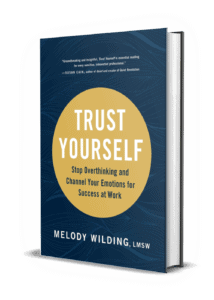As a software engineer at a major tech company in Silicon Valley, Amanda has a high-pressure, high-status job.
From the outside, she looks organized and methodical in the way she approaches her work, but on the inside, negative thoughts dominated her mind. She felt as if she was barely keeping it together.
“I’ll sit down to code,” she told me, “And when I get to a difficult part, I totally freeze up. My hands will be paralyzed above the keyboard. But my mind is going wild. I’ll replay meetings in my head, recalling how another engineer critiqued my work or beating myself up for saying something dumb.”
Once Amanda fell down that spiral in her mind, she couldn’t stop it. In an attempt to feel better, she’d try to go on social media or start answering emails. Before she knew it, the day was shot and she got zero work done. She would tell herself she’d do better tomorrow. But tomorrow was exactly the same.
How Negative Thoughts Come to Mind
Amanda is dealing with what psychologists call Automatic Negative Thoughts or ANTs.
As therapist Dr. Russ Harris explains in the book, The Happiness Trap, the brain is predisposed to focus on the negative in order to solve problems and avoid things that might hurt us.
This negativity bias can influence how we see the people and world around us, as well as affect our ability to pay attention, learn, remember, make decisions and evaluate risk.
From a neurological perspective, the brain releases chemicals when we have thoughts—positive or negative—and more importantly looks for evidence to support what we’re thinking, whether or not our thoughts are healthy or accurate.
Over time, that can change the chemistry in our body and the patterns in our brain. In other words, every time Amanda thinks, “I must be stupid because I’m getting stuck,” her body released stress hormones. Her brain would look for confirming evidence—in meetings, in past interactions—of her being “stupid.”
The types of thoughts that make up ANTs are called cognitive distortions. These unhelpful thoughts may have served us in the past, but are no longer productive.
Maybe at one point in our lives, thinking this way helped motivate us to get gold stars, earned us approval from others, or helped us feel safe in the face of fear.
But today, these feelings are what make us spiral out of control, feel bad about ourselves, or cause us to get stuck—just like Amanda.
There are lots of ways that cognitive distortions convince us of things that aren’t really true.
For example, have you ever thought the following?
- “I always fail when I try something new”
- “I am never comfortable with a bunch of people”
- “I got lucky this time”
- “I know my boss will critique my work, so I might as well not try”
- “I should be doing something better with my time”
- “I’m stressed, so I must be a pain to hang out with”
All of these are common cognitive distortions that happen to everyone—literally, everyone. Cognitive distortions are universal. But the good news is that these patterns can be changed.
How to Stop Negative Thoughts
There’s a four-step process to change unhelpful thinking patterns.
By paying more attention to how we talk to ourselves, becoming aware of distorted thoughts, and acting more compassionately way towards ourselves, we can move to a place where we stop the brain from reinforcing negativity.
This process rewires our brains to look for evidence that refutes negative thought patterns, and replace them with more realistic, balanced thinking that helps you move towards your goals.
Step 1: For the next few days, record examples of negative self-talk or troublesome thoughts that come up. In the first column of a new spreadsheet, write down the specific phrases that occupy your inner monologue.
Step 2: Label each negative thought with the type of cognitive distortion it maps to in the second column.
Step 3: Refute the distortion by generating 1 to 3 examples of situations or experiences that prove this distortion is incorrect. Write down any facts or truths that logically demonstrate why the thought is a myth. Identify external factors that may have contributed to the situation, including other people.
Step 4: Act like a “Wiser You” by pretending to be a close friend is in the same situation. What advice would you give? What would you say to encourage or comfort your friend?
For example, if Amanda was doing this exercise, her columns might look like:
1: I must be stupid because I’m always getting stuck on coding projects
2: Emotional Reasoning
3: I am not stupid because I’m the only engineer on the team who can code in JavaScript and Ruby. I have figured out workarounds for a bunch of projects, including the one I’m working on now, that my coworkers couldn’t.
4. I think you should take a quick break. Go for a walk, get a cup of coffee, and come back to work in 15 minutes. If you’re still stuck, go talk to Jeff. He’s the most seasoned engineer on the team and may have experienced a solution that you don’t know about yet. We’ve all hit a wall with coding—so don’t beat yourself up about it. If he’s not around, post in the codes Slack group to get other ideas.
You Can Stop Negative Thoughts – With Practice
In Amanda’s case, we used the exercise above for about two weeks until she started to internalize the process.
When Amanda learned how to catch and respond to her negative thoughts in the moment, she was able to look at the problem she was facing objectively and get creative about finding solutions rather than internalizing her failures and getting stuck in negative emotions.
In the end, feeling out of control is the result of letting your brain run in a groove that’s unhelpful and unproductive.
If you imagine a bowling alley, this groove is like the gutter on each side of a lane. By becoming aware of the thoughts that cause your bowling ball to spin into the gutter, what the stories or the thoughts that come up over and over again (your “greatest hits” as I call them), you can start to play differently.
You can learn how to twist your wrist to get the ball to roll straight toward the pins. You can depersonalize what you’re thinking and see it more objectively. You’re not a terrible bowler, destined to always score the lowest in any given game. You just need to undo bad habits, learn new skills, and work on how you throw the ball. And with practice, your ball will roll straight and true.









